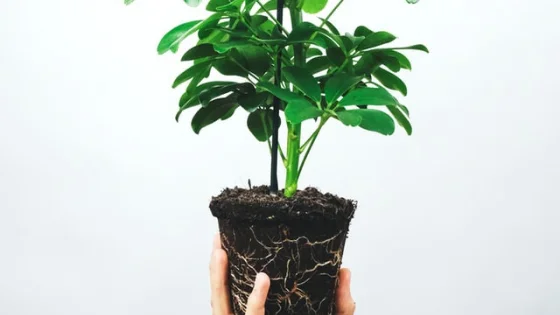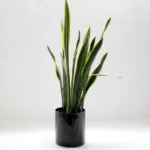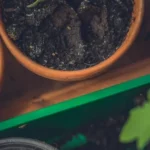The schefflera amate is a beautiful tree native to the rainforests in Australia and New Guinea. It is a fast-growing tree that, when in its natural environment, can grow up to 65 feet tall.
Also known as the Australian umbrella tree, this lovely foliage with its glossy green leaves is also suitable as a houseplant.
Table of Contents
Schefflera Amate Care
In an indoor environment, the schefflera amate typically grows anywhere from five to ten feet, the average being eight.
Despite being a tropical plant, it adapts to numerous types of environments – one of the various reasons it makes a great indoor plant. Of course, its appearance certainly makes a wonderful addition to any home or office.
What does your schefflera amate require?
This particular tree does not require a lot of special treatment – just some basics to keep it healthy.
Along with the following minimum care provisions, a person is recommended to keep checking the leaves and trunk for signs of overwatering or underwatering.
Light Requirements
The schefflera amate is one of the few larger houseplants that can survive in medium-lit areas. While it does perform better in brighter light, it can adapt to areas with a little less light. Either level of lighting should be indirect or filtered.
Placed in an eastern or northern facing window is optimal for the umbrella tree. If the foliage is placed in a southern or western-facing window, it should be placed between five and ten feet away from the window, otherwise, the leaves could burn.
It is recommended to rotate the tree to ensure each side obtains proper lighting.
Temperature Requirements
The best temperatures for this plant range between 15-26 degrees Celsius (60-80 degrees Fahrenheit).
They can tolerate temperatures as low as 10 degrees Celsius (50 degrees Fahrenheit) for short periods. The foliage should not be exposed to temperatures below this point as it could cause damage.
Humidity Requirements
Average household humidity is fine for the Australian umbrella tree, however, it does enjoy some misting.
Water Requirements
Before the initial watering, the soil should be aerated. After this point, the soil must be dry before adding more water. This dryness should extend further down past the surface otherwise a caregiver risks overwatering the tree.
The potting mix needs to be almost dried out prior before adding more moisture. In most cases, schefflera amate plants do not need watering more than once every ten days.
Soil Requirements
The best potting mix is well-draining but rich. The plant performs better when it has a slightly acidic pH of between 6 and 6.5.
Fertilizer Requirements: These trees are heavy feeders. Liquid plant food can be given twice a week during the growing season. Two applications of slow-release fertilizer pellets can be used in place of liquid plant food if necessary.
Extra Tips For Schefflera Amate
Knowing the key care requirements for the schefflera amate is essential in the foliage being healthy. There are some additional tips that can help when it comes to dealing with insects and illnesses, as well as how to prune and propagate.
Pests and Diseases
Prevention is generally the best method for dealing with insects and illnesses. However, even with this, at times, issues may arise.
To discover these problems faster, it is advised that caregivers check the leaves, branches, and trunk for signs of little critters and illnesses.
If a discovery is made, the treatment can start immediately, keeping the damage to a minimum.
- Spider Mites: These little spiders are the most common pest that bothers such trees. The creatures are usually black, white, or red. They leave dust-like webs over the leaves and branches. Their feeding damages the infested areas. When the arachnids are discovered, any damaged areas must be removed. Insecticides such as neem oil or an alternative can be applied.
- Mealybugs: These small insects are usually white or pale pink. They leave a white waxy cotton-like substance wherever they have settled. They tend to settle on the underside of leaves or other places mostly out of sight. While smaller infestations may be dealt with by killing them individually with rubbing alcohol, larger issues often require insecticides or insecticidal soap. Damaged areas must be removed in these cases too.
- Aphids: These creatures are often orange-red with black. They feed on the various parts of the tree, which is where a caregiver may see signs of their presence, such as wilted stems or yellowed leaves. Insecticides are usually required to treat this issue, and again, the damaged areas must be removed.
- Root Rot: This fungal disease is typically caused by too much moisture in the soil, sometimes from overwatering. This issue may appear as yellowed leaves that may start turning brown. The trunk near the soil may be discolored, with these effects spreading upwards as the disease worsens. In most cases, the tree requires the removal of the damaged areas and the repotting into a new pot with fresh soil. A fungicide may also be necessary.
Pruning
There are a few main reasons why a caregiver may want to prune these trees. The first is to keep its size reduced, the second is to remove damaged parts, and the third to thin out the foliage to ensure all of the leaves can obtain enough light.
While there could be other reasons, such as propagation, there are three of the most common purposes behind trimming.
Pruning the schefflera amate plant is somewhat simple. The task only requires the caregiver to cut back the stalk, as long as three or four inches remain near the soil. The job can be done with sharp, sterile scissors or pruning shears.
Propagation
Propagating a schefflera amate plant is typically done through cuttings. A stem may be cut near the base of the tree and the end wrapped in a damp paper towel. The leaves should be cut in half horizontally to prevent the stem from losing additional moisture.
After the cut end of the stem is dipped in rooting hormone, it can be placed in a six-inch pot filled with potting soil.
The stem should be placed in the soil at a depth of two inches, and the potting mix patted down around it. The pot can be placed in an area that receives steady but indirect sunlight.
The stem should start to produce roots within three weeks. Once the top of the stem begins to grow new green shoots, the tips can be snipped off to encourage faster development.
Toxicity
Schefflera amate plants are mildly toxic to humans and animals. Ingesting the plant may irritate the mouth and intestinal lining. Topical contact may cause a dermatitis-like reaction.
Because pets tend to eat more of the foliage than humans would, their reaction is often more severe and may include drooling, nausea, vomiting, and lack of appetite.
Photo by Severin Candrian on Unsplash


